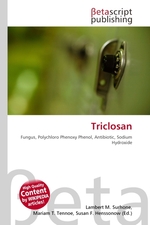Triclosan
Lambert M. Surhone, Miriam T. Timpledon, Susan F. Marseken
бумажная книга
High Quality Content by WIKIPEDIA articles! At in-use concentrations, triclosan acts as a biocide, with multiple cytoplasmic and membrane targets. At lower concentrations, however, triclosan appears bacteriostatic and is seen to target bacteria mainly by inhibiting fatty acid synthesis. Triclosan binds to bacterial enoyl-acyl carrier protein reductase enzyme (ENR), which is encoded by the gene FabI. This binding increases the enzyme's affinity for nicotinamide adenine dinucleotide (NAD+). This results in the formation of a stable ternary complex of ENR-NAD+-triclosan, which is unable to participate in fatty acid synthesis. Fatty acid is necessary for reproducing and building cell membranes. Humans do not have an ENR enzyme, and thus are not affected. Some bacterial species can develop low-level resistance to triclosan at its lower bacteriostatic concentrations due to FabI mutations, which results in a decrease of triclosan's effect on ENR-NAD+ binding, as shown in Escherichia coli and Staphylococcus aureus. Another way for these bacteria to gain low-level resistance to triclosan is to overexpress FabI
Данное издание не является оригинальным. Книга печатается по технологии принт-он-деманд после получения заказа.


